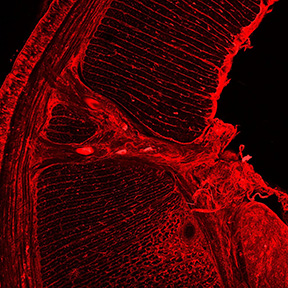 Professor of Biology
Professor of Biology
B.A. University of Pennsylvania (1974)
Ph.D. Florida State University (1979)
15 Winston Hall
(336) 758-5920
silver@wfu.edu
Areas of Interest
Comparative Physiology of the Chemical Senses, Chemesthesis
Research
Our research interest is in the chemical senses: taste, smell, and chemesthesis. We currently focus on the receptors responsible for the detection of chemesthetic stimuli. Chemesthesis is the sense of irritation caused by chemicals and mediated by the somatosensory system. In vertebrates, chemesthesis is linked to the trigeminal nerve, which innervates the eye, nose, and mouth. Examples of chemesthesis include the stinging of ammonia and the burning induced by horseradish and chili peppers. Transient Receptor Potential (TRP) channels have been shown to detect irritants and contribute to chemesthesis. For example, TRPV1 is activated by capsaicin (found in chili peppers) and TRPA1 is activated by allyl isothiocyanate (found in wasabi). We have recently begun using two invertebrate models to study chemesthesis. We use behavioral, physiological and genetic techniques to study how fruit flies and earthworms respond to irritant chemicals.
Selected Publications
(Graduate Students in Bold)
NT Blair, BI Philipson, PM Richards, JF Doerner, A Segura, WL Silver, and DE Clapham. 2015. Naturally-produced defensive compounds activate TRPA1. Chem. Senses. In Press
H Alimohammadi and WL Silver. 2015. Nasal Chemesthesis: Similarities between humans and rats observed in in vivo experiments. Chemosensory Perception 8:85-95.
CJ Saunders, WY Li, TD Patel, JA Muday, and WL Silver. 2013. Dissecting the role of TRPV1 in detecting multiple trigeminal irritants in three behavioral assays for sensory irritation. F1000Research 2:74 (doi: 10.12688/f1000research.2-74.v1) Click for paper
YY Wang, RB Chang, SD Allgood, WL Silver, and ER Liman. 2011. A TRPA1-dependent mechanism for the pungent sensation of weak acids. Journal of General Physiology 137:493-505. click for abstract
PM Richards, EC Johnson, and WL Silver. 2010. Four irritating odorants target the trigeminal chemoreceptor TRPA1. Chemosensory Perception 3:190-199. click for abstract
M Tizzano, BD Gulbransen, A Vandenbeuch, TR Clapp, JP Herman, HM Sibhatu, MEA Churchill, WL Silver, SC Kinnamon, and TE Finger. 2010. Nasal chemosensory cells use bitter taste signaling to detect irritants and bacterial signals. Proceedings of the National Academy of Sciences USA 107:3210-3215. click for abstract
WL Silver and TE Finger. 2009. Anatomical and electrophysiological basis of peripheral nasal trigeminal chemoreception. Annals of the New York Academy of Sciences 1170:202-205. click for abstract
B Gulbransen, W Silver, T and Finger. 2008. Solitary chemoreceptor cell survival is independent of intact trigeminal innervation. Journal of Comparative Neurology 508:62-71. click for abstract
WL Silver, TR Clapp, LM Stone, and SC Kinnamon. 2006. TRPV1 receptors and nasal trigeminal chemesthesis. Chemical Senses 31:807-812. click for abstract
TE Finger, B Bottger, A Hansen, KT Anderson, H Alimohammadi, and WL Silver. 2003. Solitary chemoreceptor cells in the nasal cavity serve as sentinels of respiration. Proceedings of the National Academy of Sciences USA 100:8981-6. click for abstract
ML Schaefer, B Bottger, WL Silver, and TE Finger. 2002. Trigeminal collaterals in the nasal epithelium and olfactory bulb: A potential route for direct modulation of olfactory information by trigeminal stimuli. Journal of Comparative Neurology 444: 221-226.click for abstract
TE Finger, WL Silver, and D Restrepo (editors). 2000. Neurobiology of Taste and Smell 2nd Edition . Wiley-Liss, Inc. 479 pp. click here for information
B Bryant and WL Silver. 2000. Chemesthesis: The common chemical sense. In TE Finger, WL Silver, and D Restrepo. (editors) Neurobiology of Taste and Smell 2nd Edition . Wiley-Liss, Inc. 479 pp. 73-100.
WL Silver and CL Browne. 2000. Integration of laboratory exercises in development and neurobiology courses using the Xenopus oocyte expression system. Journal of Industrial Microbiology and Biotechnology 24:353-358. click for abstract
H Alimohammadi and WL Silver. 2000. Evidence for nicotinic acetylcholine receptors on nasal trigeminal nerve endings of the rat. Chemical Senses 1:61-66. click for abstract